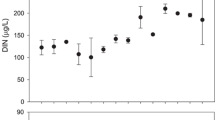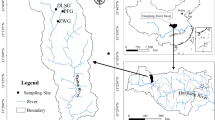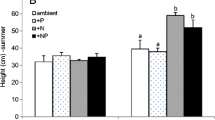Abstract
The role of algae in the metabolism of northern peatlands is largely unknown, as is how algae will respond to the rapid climate change being experienced in this region. In this study, we examined patterns in algal productivity, nutrients, and dissolved organic carbon (DOC) during an uncharacteristically wet summer in an Alaskan rich fen. Our sampling was conducted in three large-scale experimental plots where water table position had been manipulated (including both drying and wetting plots and a control) for the previous 4 years. This study allowed us to explore how much ecosystem memory of the antecedent water table manipulations governed algal responses to natural flooding. Despite no differences in water table position between the manipulated plots at the time of sampling, algal primary productivity was consistently higher in the lowered water table plot compared to the control or raised water table plots. In all plots, algal productivity peaked immediately following seasonal maxima in nutrient concentrations. We found a positive relationship between algal productivity and water-column DOC concentrations (r 2 = 0.85, P < 0.001). Using these data, we estimate that algae released approximately 19% of fixed carbon into the water column. Algal exudates were extremely labile in biodegradability assays, decreasing by more than 55% within the first 24 h of incubation. We suggest that algae can be an important component of the photosynthetic community in boreal peatlands and may become increasingly important for energy flow in a more variable climate with more intense droughts and flooding.





Similar content being viewed by others
References
APHA (1998) Standard methods for the examination of water and wastewater, 20th edn. American Public Health Association, Washington, DC
Baines SB, Pace ML (1991) The production of dissolved organic matter by phytoplankton and its importance to bacteria: patterns across marine and freshwater systems. Limnol Oceanogr 36:1078–1090
Belanger TV, Scheidt DJ, Platko JRII (1989) Effects of nutrient enrichment on the Florida Everglades. Lake Reserv Manag 5:101–111
Bergman I, Svensson BH, Nilsson MN (1998) Regulation of methane production in Swedish acid mire by pH, temperature and substrate. Soil Biol Biochem 30:729–741
Boon PI (2006) Biogeochemistry and bacterial ecology of hydrologically dynamic wetlands. In: Batzer DP, Sharitz RR (eds) Ecology of freshwater and estuarine wetlands. University of California Press, Los Angeles, pp 115–176
Bridgham SD, Johnston CA, Pastor J, Updegraff K (1995) Potential feedbacks of northern wetlands on climate change. BioScience 45:262–274
Chapin FS, Oswood MW, Van Cleve K, Viereck LA, Verbyla DL (eds) (2006) Alaska’s changing boreal forest. Oxford University Press, New York
Chin YP, Aiken GR, O‘Loughlin E (1994) Molecular weight, polydispersity, and spectroscopic properties of aquatic humic substances. Environ Sci Technol 28:1853–1858
Chivers MR, Turetsky MR, Waddington JM, Harden JW, McGuire AD (2009) Effects of experimental water table and temperature manipulations on ecosystem CO2 fluxes in an Alaskan rich fen. Ecosystems 12:1329–1342
Fogg GE (1983) The ecological significance of extracellular products of phytoplankton photosynthesis. Bot Mar 26:3–14
Gaiser EE, Scinto LJ, Richards JH, Jayachandran K, Childers DL, Trexler JD, Jones RD (2004) Phosphorus in periphyton mats provides best metric for detecting low level P enrichment in an oligotrophic wetland. Water Res 38:507–516
Giroldo D, Ortolano PIC, Vieira AAH (2007) Bacteria–algae association in batch cultures of phytoplankton from a tropical reservoir: the significance of algal carbohydrates. Freshwat Biol 52:1281–1289
Goldsborough LG, Robinson GGC (1996) Patterns in wetlands. In: Stevenson RJ, Bothwell ML, Lowe RL (eds) Algal ecology: freshwater benthic ecosystems. Academic, San Diego, pp 77–117
Gorham E (1991) Northern peatlands—Role in the carbon-cycle and probable responses to climatic warming. Ecol Appl 1:182–195
Gottlieb A, Richards J, Gaiser E (2005) Effects of desiccation duration on the community structure and nutrient retention of short and long-hydroperiod Everglades periphyton mats. Aquat Bot 82:99–112
Gremm TJ, Kaplan TJ (1997) Dissolved carbohydrates in streamwater determined by HPLC–PAD and pulse amperometric detection. Limnol Oceanogr 42:385–393
Guenet B, Danger M, Abbadie L, Lacroix G (2010) Priming effect: bridging the gap between terrestrial and aquatic ecology. Ecology 91:2850–2861
Hamer U, Marschner B (2005) Priming effects in soils after combined and repeated substrate additions. Geoderma 128:38–51
Hinzman LD, Bettez ND, Bolton WR, Chapin FS, Dyurgerov MB, Fastie CL, Griffith B, Hollister RD, Hope A, Huntington HP, Jensen AM, Jia GJ, Genson TJ, Kane DL, Klein DR, Kofinas G, Lynch AH, Lloyd AH, McGuire AD, Nelson FE, Oechel WC, Osterkamp TE, Racine CH, Romanovsky VE, Stone RS, Stow DA, Sturm M, Tweedie CE, Vourlitis GL, Walker M, Walker DA, Webber PJ, Welker JM, Winker KS, Yoshikawa K (2005) Evidence and implications of recent climate change in northern Alaska and other arctic regions. Clim Change 72:251–298
Hinzman LD, Viereck LA, Adams PC, Romanovsky VE, Yoshikawa K (2006) Climate and permafrost dynamics of the Alaskan boreal forest. In: Chapin FS, Oswood MW, Van Cleve K, Viereck LA, Verbyla DL (eds) Alaska’s changing boreal forest. Oxford University Press, New York, pp 39–61
Kane ES, Turetsky MR, Harden JW, McGuire AD, Waddington JM (2010) Seasonal ice and hydrolic controls on dissolved organic carbon and nitrogen concentrations in a boreal rich fen. J Geophys Res Biogeosci. doi:10.1029/2010JG001366
Kuzyakov Y, Friedel JK, Stahr K (2000) Review of mechanisms and quantification of priming effects. Soil Biol Biochem 32:1485–1498
Lang S, Cornelissen JHC, Klahn T, van Logtestijn RSP, Broekman R, Schweikert W, Aerts R (2009) An experimental comparison of chemical traits and litter decomposition rates in a diverse range of subarctic bryophyte, lichen and vascular plant species. J Ecol 97:886–900
McCormick PV, Chimney MJ, Swift DR (1997) Diel oxygen profiles and water column community metabolism in the Florida Everglades. USA Arch Hydrobiol 140:117–129
McCormick PV, Shuford RBE, Backus JG, Kennedy WC (1998) Spatial and seasonal patterns of periphyton biomass and productivity in the northern Everglades, Florida, USA. Hydrobiologia 362:185–208
Molot LA, Dillon PJ (1996) Storage of terrestrial carbon in boreal lake sediments and evasion to the atmosphere. Glob Biogeochem Cy 10:483–492
Myklestad SM (1995) Release of extracellular products by phytoplankton with special emphasis on polysaccharides. Sci Total Environ 165:155–164
Noe GB, Childers DL, Jones RD (2001) Phosphorus biogeochemistry and the impact of phosphorus enrichment: why the Everglades is so unique? Ecosystems 4:603–624
Osterkamp TE, Viereck L, Shur Y, Jorgenson MT, Racine C, Doyle A, Boone RD (2000) Observations of thermokarst and its impact on boreal forests in Alaska, USA. Arct Alp Res 32:303–315
Porter KG, Feig Y (1980) The use of DAPI for identification and enumeration of bacteria and blue green algae. Limnol Oceanogr 25:943–948
Press WH, Teukolsky SA, Vetterling WT, Flannery BP (eds) (1993) Numerical recipes: the art of scientific computing. Cambridge University Press, New York
Richardson CJ (2010) The Everglades: North America’s subtropical wetland. Wetl Ecol Manag 18:517–542
Roach J, Griffith B, Verbyla D, Jones J (2011) Mechanisms influencing changes in lake area in Alaskan boreal forest. Glob Change Biol. doi:10.1111/j.1365-2486.2011.02446.x
Rober AR, Wyatt KH, Stevenson RJ (2011) Regulation of algal structure and function by nutrients and grazing in a boreal wetland. J N Am Benthol Soc 30:787–796
Robinson GGC, Gurney SE, Goldsborough LG (1997) The primary productivity of benthic and planktonic algae in a prairie wetland under controlled water-table regimes. Wetlands 17:182–194
Serreze MC, Walsh JE, Chapin FS III, Osterkamp T, Dyurgerov M, Romanovsky V, Oechel WC, Morison J, Zhang T, Barry RG (2000) Observational evidence of recent change in the northern high-latitude environment. Clim Change 46:159–207
Sheffield J, Wood EF (2008) Global trends and variability in soil moisture and drought characteristics, 1950–2000, from observation-driven simulations of the terrestrial hydrologic cycle. J Clim 21:432–458
Søndergaard M, Hansen B, Markager S (1995) Dynamics of dissolved organic carbon lability in a eutrophic lake. Limnol Oceanogr 40:46–54
Smith LC, Sheng Y, MacDonald GM, Hinzman LD (2005) Disappearing Arctic lakes. Science 308:1429
Smith DJ, Underwood GJC (2000) The production of extracellular carbohydrates by estuarine benthic diatoms: the effects of growth phase and light and dark treatment. J Phycol 36:321–333
Sulman BN, Desai AR, Saliendra NZ, Lafleur PM, Flanagan LB, Sonnentag O, Mackay DS, Barr AG, van der Kamp G (2010) CO2 fluxes at northern fens and bogs have opposite responses to inter-annual fluctuations in water table. Geophys Res Lett. doi:10.1029/2010GL044018
Tarnocai CJ, Canadell G, Schuur EAG, Kuhry P, Mazhitova G, Zimov S (2009) Soil organic carbon pools in the northern circumpolar permafrost region. Glob Biogeochem Cy 23: GB2023. doi:10.1029/2008GB003327
Thomas S, Gaiser EE, Gantar M, Scinto LJ (2006) Quantifying the responses of calcareous periphyton crusts to rehydration: a microcosm study (Florida Everglades). Aquat Bot 84:317–323
Thormann MN, Bayley SE (1997) Above ground plant production and nutrient content of the vegetation in six peatlands in Alberta, Canada. Plant Ecol 131:1–16
Turetsky MR, Treat CC, Waldrop MP, Waddington JM, Harden JW, McGuire AD (2008) Short-term response of methane fluxes and methanogen activity to water table and soil warming manipulations in an Alaskan peatland. J Geophys Res Biogeosci 113: doi:10.1029/2007JG000496
Turetsky MR, Mack MC, Hollingsworth T, Harden JW (2010) Patterns in moss productivity, decomposition, and succession: implications for the resilience of Alaskan ecosystems. Can J For Res 40:1237–1264
Urban NR, Bayley SE, Eisenreich SJ (1989) Export of dissolved organic carbon and acidity from peatlands. Water Resour Res 25:1619–1628
Walker DA, Webber PJ, Binnian EF, Everett KR, Lederer ND, Nordstrand EA, Walker MD (1987) Cumulative impacts of oil fields on northern Alaskan landscapes. Science 238:757–761
Weltzin JF, Pastor J, Harth C, Bridgham SD, Updegraff K, Chapin CT (2000) Response of bog and fen plant communities to warming and water table manipulations. Ecology 81:3464–3478
Wetzel RG (1996) Benthic algae and nutrient cycling in lentic freshwater ecosystems. In: Stevenson RJ, Bothwell ML, Lowe RL (eds) Algal ecology: freshwater benthic ecosystems. Academic, San Diego, pp 641–667
Wetzel RG, Likens GE (eds) (2000) Limnological analyses, 3rd edn edn. Springer, New York
Wieder RK (2006) Primary production in boreal peatlands. In: Wieder RK, Vitt DH (eds) Boreal peatland ecosystems. Springer, New York, pp 145–164
Woo MK, Lewkowicz AG, Rouse WR (1992) Response of the Canadian permafrost environment to climate change. Phys Geogr 13:287–317
Wright RT (1988) Methods for evaluating the interaction of substrate and grazing as factors controlling planktonic bacteria. Arch Hydrobiol Monogr Beit 31:229–242
Wyatt KH, Stevenson RJ, Turetsky MR (2010) The importance of nutrient co-limitation in regulating algal community composition, productivity, and algal-derived DOC in an oligotrophic marsh in interior Alaska. Freshw Biol 55:1845–1860
Acknowledgments
This research was supported by a Hensley Fellowship from MSU and a Sigma Xi Grant-in-Aid of Research Fellowship awarded to K.H.W. This research was also supported by the National Science Foundation Grant DEB-0425328, and the Bonanza Creek Long-Term Ecological Research Program (US Forest Service grant number PNW01-JV11261952-231 and National Science Foundation grant number DEB-0080609).
Author information
Authors and Affiliations
Corresponding author
Additional information
Communicated by Robert Hall.
Rights and permissions
About this article
Cite this article
Wyatt, K.H., Turetsky, M.R., Rober, A.R. et al. Contributions of algae to GPP and DOC production in an Alaskan fen: effects of historical water table manipulations on ecosystem responses to a natural flood. Oecologia 169, 821–832 (2012). https://doi.org/10.1007/s00442-011-2233-4
Received:
Accepted:
Published:
Issue Date:
DOI: https://doi.org/10.1007/s00442-011-2233-4




